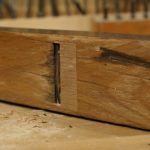We may receive a commission when you use our affiliate links. However, this does not impact our recommendations.
Each year, 400 or so woodworkers attend Colonial Williamsburg Foundation’s “Working Wood in the 18th century” conference. Attendees are treated to scholarly lectures on period furniture, including in-depth analysis of construction, conservation, and finishes, by renowned experts.
Presenters use a variety of visual aids ranging from videos, to live demonstrations, photographs, to detailed examinations of period masterpieces from Colonial Williamsburg’s impressive collections.
The Conferences are conveniently held in Colonial Williamsburg’s insane asylum. Deep beneath the spartan rooms of the 18th c mental hospital, a 200 seat lecture hall comfortably houses we lovers of 18th c furniture (2 sessions are held back to back). On stage are the work benches, tools, equipment and furniture of the 18th century. TV cameras project a detailed view of the demonstrations onto a huge movie screen behind the stage. There are no bad seats and no work is too miniscule to be seen and fully understood.
Past conferences have focused on 18th c tall case clocks, formal (Chippendale) chairs, tables, and case work to name a few. This year’s topic was 17th century joinery. The conference opened with a look at chests and court cupboards from the period. Furniture from the 17th c is scarce in America, but Williamsburg’s Associate Curator Tara Gleason Chicirda had several examples to show us. Tara’s evening lecture leveraged photographs and several period pieces.
The bottom of this 17th c court cupboard has been worn away, exposing the mortises. Note the riven stiles, and odd tenon strategy at left. Talk about turning your face to London!
The lecture was followed by a cocktail hour. Williamsburg’s conference planners include several socials; breakfasts, evening cocktail parties and even a fancy dinner. Though it might sound corny, and despite the wonderful presenters, I really look forward to chatting with my fellow attendees just as much as the presentations. They are a fascinating bunch of people and truly a nicer group of folks you’d be hard pressed to find.
The next two days was spent with two teams of presenters working on different projects; Peter Follansbee (master joiner www.plimoth.org) and John Alexander (author of the truly seminal text “Make a Chair from a Tree”) demonstrated the construction of a joint stool starting with a section of log. The following day, Peter demonstrated early box making and carving technique (white oak by the way).
Colonial Williamsburg’s carpenters, Master Housewright Garland Wood, and Journeyman carpenter Ted Boscana constructed a really rather complicated court cupboard. (Ted appeared with his pitsaw in my article on stock prep.) While I usually think of carpenter’s work as being somewhat coarse in nature, it was not evident in their work. Using simple tools they flawlessly executed joint after joint under the bright lights and attentive scrutiny of 200 period woodworkers.
17th c work is pretty crude. I don’t think I was the only one struggling to admire the designs, joinery, and surface work. Despite the value in seeing other furniture styles, other solutions to similar problems, there was a refreshing “just do it” aspect to the demonstrations that I found encouraging. The drawer front is attached to this side hung drawer with a single dovetail. The bottom is made up of spare clapboards or simple riven billets.
Ernie Conover showed samples of his skill by turning on the Hay shop’s great wheel lathe. The show wrapped up with period paint expert Susan Buck discussing and demonstrating period finishes including paint.
Next year’s topic is as yet unknown. Registration usually begins in the Fall and depending on the topic, sessions fill up quickly. The price for one evening, and three full days of lectures including the banquet was about $250 (correct me if I’m wrong). In the dead of Winter, Williamsburg’s many hotels offer deals. I try to find the cheapest room in town each year. This year, like last, I stayed at the Days Inn on Richmond Road which is a pleasant 2 mile walk (past William and Mary College) to the insane asylum. My room with a king sized bed, cable TV and free high speed internet access was about $32/night. The Days Inn is also about Ã?½ mile from the Green Leaf CafÃ?©, a college bar with Boddington’s and 29 other fine brews on tap.
P.S. I promised to include some shots of Peter’s wonderfully exhuberant carvings:
Here are some supplies and tools we find essential in our everyday work around the shop. We may receive a commission from sales referred by our links; however, we have carefully selected these products for their usefulness and quality.









Thanks, Adam. Fine report. Appreciate the specifics on conference details. Hope to attend next year.
Thanks for the report, Adam. What species are those carved boxes?
Thanks for the report, and the great pictures! I had really hoped to make the Williamsburg conference, but in a fit of practicality stayed home to work 🙁
Special thanks for the carving pictures at the end. Wow! Does Peter make his carvings pop. I built a box that used the same pattern as the first one you show, but I can only wish my work was as crisp as his…
Adam,
What a great report! Kind of makes one which that they were present as well. This report was almost as inspiring as your latest article in Pop Wood – "18th-century Stock Prep" in which if one does not want to go out and prep some boards, then truly their passion is not working wood 18th century style. Again, great report and thanks for posting; quickly, post more items, this is extremely encouraging to those of us who like you, desire to do everything with hand tools.
Best regards,
Roderick